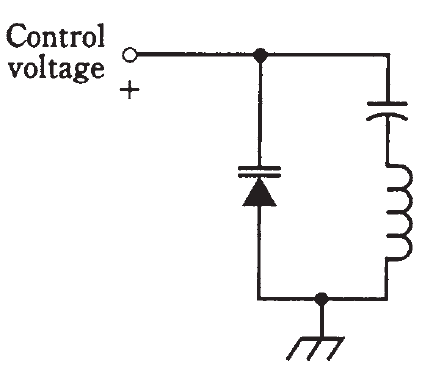


 الفيزياء الكلاسيكية
الفيزياء الكلاسيكية
 الكهربائية والمغناطيسية
الكهربائية والمغناطيسية
 علم البصريات
علم البصريات
 الفيزياء الحديثة
الفيزياء الحديثة
 النظرية النسبية
النظرية النسبية
 الفيزياء النووية
الفيزياء النووية
 فيزياء الحالة الصلبة
فيزياء الحالة الصلبة
 الليزر
الليزر
 علم الفلك
علم الفلك
 المجموعة الشمسية
المجموعة الشمسية
 الطاقة البديلة
الطاقة البديلة
 الفيزياء والعلوم الأخرى
الفيزياء والعلوم الأخرى
 مواضيع عامة في الفيزياء
مواضيع عامة في الفيزياء|
Read More
Date: 11-5-2021
Date: 16-5-2021
Date: 5-4-2021
|
Frequency control
When a diode is reverse-biased, there is a region at the P-N junction with dielectric properties. As you know from the last chapter, this is called the depletion region, because it has a shortage of majority charge carriers. The width of this zone depends on several things, including the reverse voltage.
As long as the reverse bias is less than the avalanche voltage, varying the bias can change the width of the depletion region. This results in a change in the capacitance of the junction. The capacitance, which is always quite small (on the order of picofarads), varies inversely with the square root of the reverse bias.
Some diodes are manufactured especially for use as variable capacitors. These are varactor diodes. Sometimes you’ll hear them called varicaps. They are made from silicon or gallium arsenide.
A common use for a varactor diode is in a circuit called a voltage-controlled oscillator (VCO). A voltage-tuned circuit, using a coil and a varactor, is shown in Fig. 1.
This is a parallel-tuned circuit. The fixed capacitor, whose value is large compared with that of the varactor, serves to keep the coil from short-circuiting the control voltage across the varactor. Notice that the symbol for the varactor has two lines on the cathode side. This is its “signature,” so that you know that it’s a varactor, and not just an ordinary diode.

Fig. 1: Connection of a varactor diode in a tuned circuit.



|
|
|
|
مخاطر عدم علاج ارتفاع ضغط الدم
|
|
|
|
|
|
|
اختراق جديد في علاج سرطان البروستات العدواني
|
|
|
|
|
|
|
مدرسة دار العلم.. صرح علميّ متميز في كربلاء لنشر علوم أهل البيت (عليهم السلام)
|
|
|